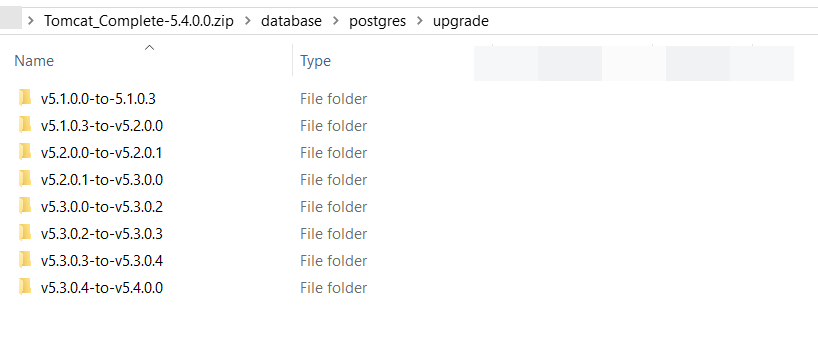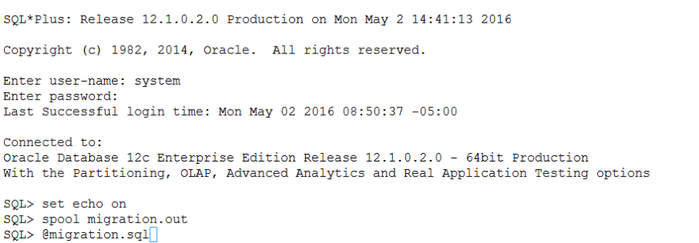Tomcat Upgrade (from FlexDeploy 5.3.0.x or lower)
This page provides instructions for upgrading a FlexDeploy installation from version 5.3.0.5 or lower to 5.4. This instructions will upgrade Tomcat from version 8.5.11 to 9.0.34.
Make sure you have downloaded new version of FlexDeploy and unzipped it, so it can be accessed during upgrade process.
Upgrade Instructions
Step 1. Stop the Tomcat server. Use shutdown.sh on Linux and shutdown.bat on Windows.
Step 2. Backup the FlexDeploy schemas and Artifact Repository. In case you need to back out FlexDeploy, you can use these backup data.
For back-out purposes, it is highly recommended that a database backup of the database be taken using standard tools like RMAN for Oracle. Another option would be to export the FD, FD_ADMIN, and FF schemas using data pump. The schemas can be exported using the following data pump command for Oracle as shown below. Follow standard procedures for PostgreSQL and MySQL for database backup.
Recommendation for Oracle database backup
You will need to setup environment variables before running expdp. For example,
export ORACLE_HOME=/u01/app/oracle/product/12.1.0/dbhome_1export ORACLE_SID=fd01
export statements above are for example only as values will be different for your installation.
expdp system directory=DATA_PUMP_DIR dumpfile=fd_bkup.dmp schemas=FD,FF,FD_ADMIN
If this database is exclusively used for just FlexDeploy application, you can rely on Database backup and recovery processes (RMAN)
instead of export data procedure.
It is recommended that a backup of the artifact repository file system be taken in case a back-out is required. The location of the artifact repository can be identified by looking at value of -Dflexagon.fd.repository.root in setenv.sh or setenv.bat file. This file will be in <FlexDeploy Home>/apache-tomcat-flexdeploy/bin/. Standard file backup procedures can be followed. Optionally, the following command (unix only) can be used to create a tar file backup of the entire directory.
Backup Artifact Repository
cd <artifact repository location>
tar –cvzf artifact.tar.gz <artifact repository location>
Step 3. Upgrade the FlexDeploy schemas
Locate upgrade scripts folder in distribution zip file. For example, /database/oracle/upgrade, /database/postgres/upgrade, /database/mysql/upgrade. This folder(s) includes a number of folders containing migration.sql, which upgrade the FlexDeploy schemas.
As part of FlexDeploy 5.4 upgrade, missing UK constraint was added for REL_METADATA_VALUE table. Please check that there are no duplicate rows by running following SQL prior to upgrade. If you find duplicates then contact us via support portal.
SELECT * FROM (SELECT REL_DEFINITION_ID, PIPELINE_METADATA_ID, COUNT(1) NUMROWS FROM FD.REL_METADATA_VALUE GROUP BY REL_DEFINITION_ID, PIPELINE_METADATA_ID) WHERE NUMROWS>1;
If you are upgrading from version prior to FlexDeploy 5.2, run following SQL prior to running upgrade scripts and make sure no rows are returned. If there are any row returned, it is possible that migration may not work correctly, in which case contact us via support portal.
SELECT
kd.property_key_name, k.*
FROM
fd.property_key k,
fd.property_key_definition kd,
fd.property_value pv
WHERE
k.property_definition_id = kd.property_definition_id
AND pv.sequence_number = 0
AND k.property_key_id = pv.property_key_id
AND kd.is_encrypted = 'Y'
AND k.is_encrypted = 'N'
AND pv.property_value not in ('<NOT CONFIGURED>', '<OPTIONAL>');
FlexDeploy 5.1 migration includes updates to Unique Constraint for FF.DB_PROPERTIES_DATA. If you are upgrading from version prior to 5.1, then run following SQL before running upgrade scripts. If you have duplicates then it needs to be fixed up prior to starting migration. If there are duplicates, work with Flexagon support team to resolve prior to migration.
SELECT * FROM (SELECT DB_PROPERTIES_ID, SEQUENCE_NUMBER, COUNT(1) NUMROWS FROM FF.DB_PROPERTIES_DATA GROUP BY DB_PROPERTIES_ID, SEQUENCE_NUMBER) WHERE NUMROWS>1;
You will need to execute one or more SQL script(s) from the version of FlexDeploy you currently have, up to the latest version. And they must be executed in that order.
See some examples below to help you understand database upgrade process.
v5.2.0.0-to-5.2.0.1/migration.sql v5.2.0.1-to-5.3.0.0/migration.sql v5.3.0.0-to-v5.3.0.2/migration.sql v5.3.0.2-to-v5.3.0.3/migration.sql v5.3.0.3-to-v5.3.0.4/migration.sql v5.3.0.4-to-v5.4.0.0/migration.sql
v5.3.0.0-to-v5.3.0.2/migration.sql v5.3.0.2-to-v5.3.0.3/migration.sql v5.3.0.3-to-v5.3.0.4/migration.sql v5.3.0.4-to-v5.4.0.0/migration.sql
v5.3.0.2-to-v5.3.0.3/migration.sql v5.3.0.3-to-v5.3.0.4/migration.sql v5.3.0.4-to-v5.4.0.0/migration.sql
Executing migration files
Once you have decided which migration scripts to execute, you need to run them against your database using database specific tools in proper sequence.
Oracle
These scripts should be executed as system, sys, or another user which has privileges to create objects in other schemas, performs grants, etc. You can load and execute these scripts using other tools such as Toad or SQL Developer. Instructions below are for using the sqlplus client.
sqlplus
Oracle SQL*Plus is part of the Oracle Client, and may be executed on any host which has it installed. If the Oracle Client is not installed on the same host as where you are installing FlexDeploy, you can copy the scripts to another host which has it installed.
Make sure to spool output to a file, so it can be analyzed later if necessary.
To launch sqlplus:
export ORACLE_HOME=<your Oracle Home directory> export ORACLE_SID=<the SID of your database> spool migration5.2.0.out #(change for each script execution so logs are preserved) $ORACLE_HOME/bin/sqlplus #(login as sys or system when prompted) SQL> <<execute scripts as shown above>>
If running on another host other than the database server, you must update your tnsnames file and and launch sqlplus as follows:
export ORACLE_HOME=<your Oracle Home directory> export ORACLE_SID=<the SID of your database> spool migration5.2.0.out #(change for each script execution so logs are preserved) $ORACLE_HOME/bin/sqlplus system@<tnsname> SQL> <<execute scripts as shown above>>
For example,
PostgreSQL
These scripts should be executed as postgres or another super user which has privileges to create objects in other schemas, performs grants, etc. Change the bold text as needed in your environment.
Linux
- Run FlexDeploy migration scripts. Type the password when asked. PostgresDDL.txt records the output of the script so that you can refer back to it later.
- cd <Flexdeploy Unzip Folder>\database\postgres\upgrade\vx.y.0.z-v.a.b.0.c
- /path/to/psql -U postgres -h hostname -p 5432 -d flexdeploy -a -b -e -f migration.sql > PostgresDDL.txt
Windows
- Run FlexDeploy scripts. Type the password when asked. PostgresDDL.txt records the output of the script so that you can refer back to it later.
- cd <Unzip Folder>/database/postgres/upgrade/vx.y.0.z-v.a.b.0.c
- C:\path\to\psql -U postgres -h hostname -p 5432 -d flexdeploy -a -b -e -f migration.sql > PostgresDDL.txt
Step 4. Take a backup and delete entire apache-tomcat-flexdeploy folder (this will be replaced by new copy). It will be required since the old configuration files will need to be referenced. See example below for Linux.
# Assuming FLEXDEPLOY_HOME environment variable is set, it should be parent folder of apache-tomcat-flexdeploy cd $FLEXDEPLOY_HOME mv apache-tomcat-flexdeploy/ apache-tomcat-flexdeploy-53/
Step 5. Copy apache-tomcat-flexdeploy folder from distribution zip.
If you had placed additional libraries in apache-tomcat-flexdeploy/lib folder, then you will need to copy them from backup folder. Examples might be JDBC driver (for Oracle drivers there is additional detail in step 6), CyberArk libraries for Tomcat connection pool provider etc.
cd $FLEXDEPLOY_HOME mkdir apache-tomcat-flexdeploy # assuming download zip has been unzipped in UNZIPPED_FLEXDEPLOY folder. cd $UNZIPPED_FLEXDEPLOY/apache-tomcat-flexdeploy cp -R * $FLEXDEPLOY_HOME/apache-tomcat-flexdeploy/ cd $FLEXDEPLOY_HOME/apache-tomcat-flexdeploy/ chmod +x ./bin/*.sh
Step 6. Copy the context.xml file from the backup folder (step 4) into <FlexDeploy Home>/apache-tomcat-flexdeploy/conf
cd $FLEXDEPLOY_HOME/apache-tomcat-flexdeploy-53/conf/ cp context.xml ../../apache-tomcat-flexdeploy/conf/
If using Oracle database, it is recommended to use UCP connection pool (see details below), otherwise go to Step 7.
- Download the Oracle JDBC 8 driver from https://www.oracle.com/database/technologies/appdev/jdbc-ucp-19c-downloads.html. For example, ojdbc8-full.tar.gz.
- Remove ojdbc jar files like ojdbc*.jar or ojdbc*dms.jar from <FlexDeploy Home>/apache-tomcat-flexdeploy/lib.
- Copy ojdbc8.jar, ons.jar and ucp.jar from downloaded jdbc driver to <FlexDeploy Home>/apache-tomcat-flexdeploy/lib.
- Update <FlexDeploy Home>/apache-tomcat-flexdeploy/conf/context.xml as shown below.
<Resource name="jdbc/flexdbDS" auth="Container"
type="oracle.ucp.jdbc.PoolDataSource"
factory="oracle.ucp.jdbc.PoolDataSourceImpl"
connectionFactoryClassName="oracle.jdbc.pool.OracleDataSource"
minPoolSize="0"
maxPoolSize="100"
initialPoolSize="0"
autoCommit="false"
inactiveConnectionTimeout="300"
url="jdbc:oracle:thin:@(DESCRIPTION=(ADDRESS_LIST=(ADDRESS=(PROTOCOL=tcp)(HOST=**HOSTNAME**)(PORT=**PORT**)))(CONNECT_DATA=(SERVICE_NAME=**SERVICE_NAME**)))"
user="fd_admin"
password="**FD_ADMIN_PASSWORD**"
fastConnectionFailoverEnabled="true"
validationQuery="select 1 from dual"
testOnBorrow="true"
useLocalSessionState="true"
defaultAutoCommit="false"/>
- URL must be in the format listed in the example, the JDBC short format of host:sid:port should not be used.
- If RAC is used for the database, multiple nodes can be listed in the address list of the URL or it can point to the scan listener for the cluster.
- Sample URL for a RAC implementation that has a primary and secondary scan listener connecting to to a service name GOLD-CLOUD. This includes connection timeout, retry, and retry delay settings.
url="jdbc:oracle:thin:@(DESCRIPTION = CONNECT_TIMEOUT=120) (RETRY_COUNT=20) (RETRY_DELAY=3) (TRANSPORT_CONNECT_TIMEOUT=3) (ADDRESS_LIST =(LOAD_BALANCE=on) (ADDRESS = (PROTOCOL = TCP) (HOST=primary-scan) (PORT=1521))) (ADDRESS_LIST =(LOAD_BALANCE=on) (ADDRESS = (PROTOCOL = TCP) (HOST=secondary-scan) (PORT=1521))) (CONNECT_DATA=(SERVICE_NAME = gold-cloud)))"
- See Implementing UCP connections with Tomcat and Oracle for more information.
Step 7. Edit the server.xml and modify the HTTP/HTTPS ports to match that of the original file which was backed up in step 4. This file is located in the<FlexDeploy Home>/apache-tomcat-flexdeploy/conf folder. DO NOT simply copy over the backup file as there are other changes which must be preserved.
Step 8. Copy setenv.sh and setenv.bat from the backup folder (step 4) into<FlexDeploy Home>/apache-tomcat-flexdeploy/bin
cd $FLEXDEPLOY_HOME/apache-tomcat-flexdeploy/bin cp ../../apache-tomcat-flexdeploy-53/bin/setenv* . chmod 775 setenv*
Step 9. Copy plugins from download zip for auto upload.
FlexDeploy download zip contains plugin jar files. You just need to 1) copy plugin jars from download zip to plugins folder in your installation (details explained below) and 2) all files will be automatically uploaded and 3) activated on the server startup.
- Plugin files to copy are in following location in download zip.
- Tomcat Download - application/plugins
- WebLogic Download - plugins
- Let's determine where to copy files in your installation now. Locate flexagon.fd.install.root folder for your FlexDeploy installation, which is FlexDeploy working directory. This is specified on the Java command line. For example, -Dflexagon.fd.install.root=/u01/flexdeploy/application.
- For Tomcat, you can look for this information in setenv.bat or setenv.sh file depending whether using Windows or Unix.
- For Weblogic, find it in the managed server startup settings.
- Create plugins folder if it does not exist under flexagon.fd.install.root folder. Copy files from download zip (#1 above) to this plugins folder.
Step 10 . Start tomcat by running the following script
<FlexDeploy Home>/apache-tomcat-flexdeploy/bin/startup.sh (startup.bat on Windows)
Step 11. Launch FlexDeploy in your browser - http://<hostname>:<port>/flexdeploy
Step 12. There is no need to activate plugins manually. FlexDeploy will automatically upload and activate new versions of plugins once they are copied to plugins folder. You will notice that plugins that you copied in Step 8 will eventually be uploaded automatically and folder will not have any jar files left. You can also look at Administration - Plugins in UI and see newer versions of plugins.
- style


